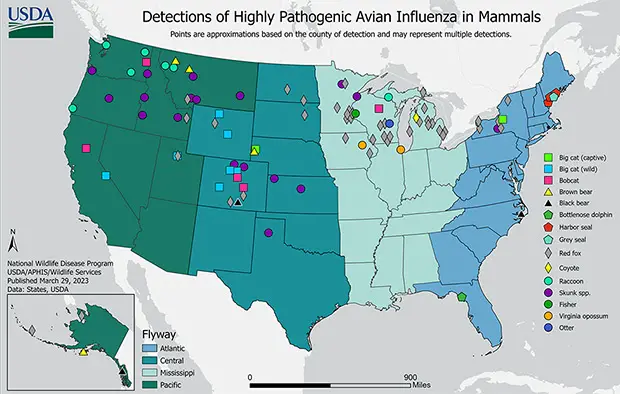Of the four influenza virus types—A, B, C, and D—all can infect animals and type D is known to only infect humans. Influenza type A viruses include the highly pathogenic avian flu subtypes, such as H5N1, H7N9, and H9N2, as well as the swine flu subtypes H5N1 and H9N2.
No known human-to-human spread has occurred with the H5N1 virus that is currently circulating in birds in the U.S. and globally, according to the Centers for Disease Control and Prevention (CDC). Sporadic human cases of H5N1 reported with H5N1 viruses circulating in birds since 2021 have occurred following exposure to infected poultry.
On March 29, the USDA first published its data on cases of HPAI infections in mammals from 2022 to late March 2023. The H5N1 virus subtype was detected in numerous species: bobcat, black and brown bears, bottlenose dolphin, harbor and grey seals, mountain lion, red fox, raccoon, striped skunk, and more.
Susceptibility to HPAI varies by mammalian species and even by individual animal, as is the case for wild birds, explained Rebecca Poulson, PhD, assistant research scientist with the Southeastern Cooperative Wildlife Disease Study at the University of Georgia College of Veterinary Medicine.
Wild mammals in which HPAI has been detected include many mesocarnivores that likely contracted the virus by eating HPAI-infected prey, Dr. Poulson continued. Behavior, diet, and previous exposure to influenza virus are among a complex set of factors to take into account.
“Spillover of HPAI from wild birds to mammals is not a simple process, with host, virus, and environmental factors at play,” she said. “And despite being well over a year into this wildlife disease outbreak in North America, continued emphasis on research and surveillance to answer these sorts of questions is critically important.”
Also unknown is just how virulent HPAI is to wild animals and if an infected animal can transmit the virus to offspring or other animals.
Many of these detections have been seemingly one-off events that have not persisted,” Dr. Poulson said. “However, there have been events among seals along the North Atlantic Coast and sea lions in Peru marked by a lot of HPAI-associated morbidity and mortality.”
Continued prioritization of sustained funding for surveillance and research to better understand HPAI in wildlife species is critical, according to Dr. Poulson.
“If we think about all the interfaces where wild birds, mammals, humans, and domestic animals overlap, the need to truly prioritize such work really becomes clear,” she said. “Better understanding HPAI transmission, persistence, and the genetic and phenotypic changes these viruses undergo the longer they are circulating in wild animals is key to being able to assess risk and make informed management decisions.”
